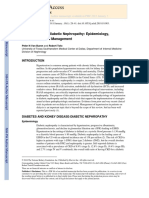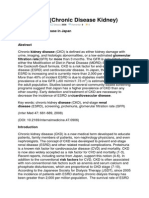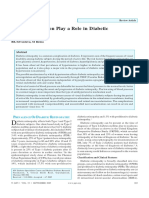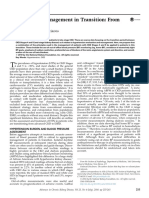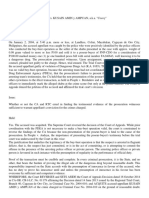First Page PDF
First Page PDF
Uploaded by
Sumit ChaudharyCopyright:
Available Formats
First Page PDF
First Page PDF
Uploaded by
Sumit ChaudharyOriginal Description:
Original Title
Copyright
Available Formats
Share this document
Did you find this document useful?
Is this content inappropriate?
Copyright:
Available Formats
First Page PDF
First Page PDF
Uploaded by
Sumit ChaudharyCopyright:
Available Formats
Disease-a-Month 61 (2015) 387–395
Contents lists available at ScienceDirect
Disease-a-Month
journal homepage: www.elsevier.com/locate/disamonth
Hypertension and chronic kidney disease
Richard Gargiulo, DO, Faten Suhail, MD, Edgar V. Lerma, MD
Epidemiology
Hypertension (HTN) and chronic kidney disease (CKD) have a unique relationship in that they
are both a cause and consequence of each other. Essential HTN is the second leading cause of
kidney disease in the United States behind only diabetes.1 CKD is currently estimated to affect
about 26 million people in the United States alone.2 African Americans and Hispanics have been
shown to be at greater risk for CKD and for faster development to end-stage renal disease
(ESRD).3 HTN is found in 80–85% of all CKD patients, with a higher prevalence being seen in
those with worse kidney function. The MDRD study showed HTN prevalence increasing from
65% to 95% as glomerular filtration rates (GFR) decreased from 85% to 15%.4 Multiple studies
have proven uncontrolled HTN to be a strong risk factor for progression of CKD to ESRD and
severe cardiovascular effects including heart disease and stroke.5 Resistant HTN and nocturnal
HTN are also found at higher rates in CKD patients and have been shown to result in a faster
renal decline and more cardiovascular complications.6,7 Treatment goals have recently been
changing due to new guidelines published by multiple medical societies, but overall, there has
been improvement in obtaining optimal blood pressure levels. The CRIC study, a cohort study of
3612 CKD patients in 2010, showed that 67% of patients reached their blood pressure goal of
o 140/90 mmHg and 46% reached their goal of o 130/90 mmHg. This is compared to HTN
control rates in the general population of 50% from 2007 to 2008.3,8
Pathophysiology
Abnormalities of sodium homeostasis are required for the development of HTN and play a
significant role in the development in CKD-associated HTN. Normal blood pressure levels are
usually tightly maintained through a process called “pressure natriuresis.” This occurs when the
renal vasculature notices an acute rise in systemic blood pressure leading to increased renal
sodium excretion and subsequent loss of extracellular fluid, thereby decreasing the overall blood
pressure. This mechanism also works in reverse, by retaining sodium and fluid when blood
pressure is low.9 The physiologic changes of CKD result in fewer nephrons and abnormal renal
tubular exchange leading to a decline in sodium excretion in a hypertensive environment.9,10
This causes a blunting of the normal diuretic response seen in pressure natriuresis and therefore
an inability to effectively decrease blood pressure elevations through sodium and fluid excretion.
http://dx.doi.org/10.1016/j.disamonth.2015.07.003
0011-5029/& 2015 Mosby, Inc. All rights reserved.
You might also like
- Reference For Reading On HypertensionDocument9 pagesReference For Reading On HypertensionShaina MentangNo ratings yet
- 63 - Original ArticleDocument5 pages63 - Original ArticlechairulNo ratings yet
- Pi Is 0272638616302645Document9 pagesPi Is 0272638616302645Eko PrasNo ratings yet
- Management of HT in DNDocument23 pagesManagement of HT in DNyosefsugiNo ratings yet
- 2015 Updates On The Management of Diabetes in Dialysis PatientsDocument22 pages2015 Updates On The Management of Diabetes in Dialysis Patientsguanyulin01No ratings yet
- Diabetes and Hypertension: A Comprehensive Report On Management and The Prevention of Cardiovascular and Renal ComplicationsDocument3 pagesDiabetes and Hypertension: A Comprehensive Report On Management and The Prevention of Cardiovascular and Renal Complicationsrizqi_cepiNo ratings yet
- Anemia in CKD Patient On HeamodialysisDocument32 pagesAnemia in CKD Patient On HeamodialysisEditor IJTSRDNo ratings yet
- Hypertension ThesisDocument31 pagesHypertension ThesisNavin AdhikariNo ratings yet
- Management of Hypertension in CKD 2015Document9 pagesManagement of Hypertension in CKD 2015Alexander BallesterosNo ratings yet
- HHS Public Access: Early Chronic Kidney Disease: Diagnosis, Management and Models of CareDocument27 pagesHHS Public Access: Early Chronic Kidney Disease: Diagnosis, Management and Models of Careursula_ursulaNo ratings yet
- Hyperuricaemia and Gout in Cardiovascular, Metabolic and Kidney Disease - ScienceDirectDocument1 pageHyperuricaemia and Gout in Cardiovascular, Metabolic and Kidney Disease - ScienceDirectDonna PakpahanNo ratings yet
- Title Page: World Kidney Day 2011: Protect Your Kidneys, Save Your HeartDocument11 pagesTitle Page: World Kidney Day 2011: Protect Your Kidneys, Save Your HeartIsidoritarcNo ratings yet
- End Stage Renal DiseaseDocument62 pagesEnd Stage Renal DiseaseMae Navidas DigdiganNo ratings yet
- 28 Ismail EtalDocument9 pages28 Ismail EtaleditorijmrhsNo ratings yet
- Dietary Therapy in Hypertension: Clinical TherapeuticsDocument11 pagesDietary Therapy in Hypertension: Clinical TherapeuticsIsti YaniNo ratings yet
- Nihms 260877 PDFDocument23 pagesNihms 260877 PDFfebyan yohanesNo ratings yet
- Chronic Kidney Disease and Its Management: A ReviewDocument3 pagesChronic Kidney Disease and Its Management: A ReviewBaru Chandrasekhar RaoNo ratings yet
- Up-Date On Diabetic NephropathyDocument17 pagesUp-Date On Diabetic NephropathykvyNo ratings yet
- 837pm - 18.EPRA JOURNALS11005Document11 pages837pm - 18.EPRA JOURNALS11005Afsana UmmeeNo ratings yet
- Am J Kidney Dis 2014 Oct 64 (4) 510Document24 pagesAm J Kidney Dis 2014 Oct 64 (4) 510hrol31060No ratings yet
- Uric Acid in HypertensivesDocument54 pagesUric Acid in Hypertensivesnikhilrathiand24No ratings yet
- 2 DR - Husna Siddiqua Thesis FinalDocument73 pages2 DR - Husna Siddiqua Thesis Finalcity9848835243 cyberNo ratings yet
- 3 Lastra Et Al., 2014 Review - Type 2 Diabetes Mellitus and Hypertension An UpdateDocument20 pages3 Lastra Et Al., 2014 Review - Type 2 Diabetes Mellitus and Hypertension An Updatebangd1f4nNo ratings yet
- Falla Cardiaca en DiabetesDocument46 pagesFalla Cardiaca en Diabeteskelly johanna salas martinezNo ratings yet
- Jurnal CKD (Chronic Disease Kidney)Document9 pagesJurnal CKD (Chronic Disease Kidney)Ruby WrightNo ratings yet
- CKD HT 3Document8 pagesCKD HT 3Peer TutorNo ratings yet
- Chiu 2016Document7 pagesChiu 2016alan arroyoNo ratings yet
- Lifestyle Modification and Hypertension Prevention: Sima Ghezelbash, Azam GhorbaniDocument6 pagesLifestyle Modification and Hypertension Prevention: Sima Ghezelbash, Azam Ghorbanineway workuNo ratings yet
- CHAPTER TWO ThesisDocument14 pagesCHAPTER TWO Thesisismail farah indhogudhanNo ratings yet
- Treatment of Hypertension in The ElderlyDocument13 pagesTreatment of Hypertension in The ElderlyChia Yin NgNo ratings yet
- Jurnal Chronic Kidney Disease in Japan Kunitoshi IsekiDocument8 pagesJurnal Chronic Kidney Disease in Japan Kunitoshi IsekiJihan FhatinaNo ratings yet
- Hipertensi Dalam Retinopati DMDocument6 pagesHipertensi Dalam Retinopati DMivanaNo ratings yet
- Hubungan Neutrophyl To Lymphocyte Ratio Dengan Derajat Disfungsi Diastolik Pada Pasien HipertensiDocument7 pagesHubungan Neutrophyl To Lymphocyte Ratio Dengan Derajat Disfungsi Diastolik Pada Pasien HipertensiLutfhi ArshaldoNo ratings yet
- A Study To Assess Changes in The Hematological Profile in Chronic Kidney DiseaseDocument3 pagesA Study To Assess Changes in The Hematological Profile in Chronic Kidney Diseasemandhalanarshimlu48141No ratings yet
- In Practice Management of Gout and Hyperuricemia in CKD: Ana Beatriz Vargas-Santos, MD, and Tuhina Neogi, MD, PHD, FRCPCDocument18 pagesIn Practice Management of Gout and Hyperuricemia in CKD: Ana Beatriz Vargas-Santos, MD, and Tuhina Neogi, MD, PHD, FRCPCSpamie FabulaNo ratings yet
- Jurnal Chronic Kidney Disease in Japan Kunitoshi IsekiDocument8 pagesJurnal Chronic Kidney Disease in Japan Kunitoshi IsekiSiska KhairNo ratings yet
- By DR - Vasudeva Chetty PakalaDocument97 pagesBy DR - Vasudeva Chetty Pakalaace forumNo ratings yet
- Hypertension Pathophysiology and TreatmentDocument8 pagesHypertension Pathophysiology and TreatmentrizkaNo ratings yet
- Chronic Kidney Disease: PathophysiologyDocument11 pagesChronic Kidney Disease: Pathophysiologymiguel_81908No ratings yet
- IntroductionDocument4 pagesIntroductionCristina L. JaysonNo ratings yet
- NcbiDocument10 pagesNcbiFebby AuliaNo ratings yet
- Hubungan Kadar Kolesterol Total Dan Asam Urat Dengan Kejadian Hipertensi Di Wilayah Pesisir Kabupaten Konawe UtaraDocument8 pagesHubungan Kadar Kolesterol Total Dan Asam Urat Dengan Kejadian Hipertensi Di Wilayah Pesisir Kabupaten Konawe Utarayuyun usratinNo ratings yet
- 6article PDFDocument12 pages6article PDFMillenium AyurvedaNo ratings yet
- Ban JASH2009Document15 pagesBan JASH2009Adek FahmialdiNo ratings yet
- Hipertnsi DMDocument11 pagesHipertnsi DMauliamulidaNo ratings yet
- Importance of Blood Pressure Control in CKD PDFDocument6 pagesImportance of Blood Pressure Control in CKD PDFkhangsiean89No ratings yet
- Gout in CKDDocument6 pagesGout in CKDNatasya Ryani PurbaNo ratings yet
- Cardiac Autonomic Neuropathy in Diabetes: A Clinical PerspectiveDocument8 pagesCardiac Autonomic Neuropathy in Diabetes: A Clinical PerspectiveHandriee Oka DiputeraNo ratings yet
- Chronic Kidney Disease and Its ComplicationsDocument6 pagesChronic Kidney Disease and Its ComplicationsmedicalNo ratings yet
- ESRDDocument8 pagesESRDad3_aaaNo ratings yet
- 01 Hyp 37 4 1053Document7 pages01 Hyp 37 4 1053AuliaNo ratings yet
- Issab Linda Aldosetrone ThesesDocument18 pagesIssab Linda Aldosetrone ThesesIssahaku AbdallahNo ratings yet
- Cardiovascular Disease and Its Relationship With Chronic Kidney DiseaseDocument9 pagesCardiovascular Disease and Its Relationship With Chronic Kidney Diseasetrinda ireneNo ratings yet
- Hypertension in People With Type 2 DiabetesDocument6 pagesHypertension in People With Type 2 DiabetesIgor CampanaNo ratings yet
- Association of High Blood Pressure With RenalDocument6 pagesAssociation of High Blood Pressure With RenalBima AryaputraNo ratings yet
- Device Therapy in Heart Failure Patients With Chronic Kidney DiseaseDocument8 pagesDevice Therapy in Heart Failure Patients With Chronic Kidney DiseaseElizabeth SniderNo ratings yet
- Early Chronic Kidney DiseaseDocument12 pagesEarly Chronic Kidney DiseaseDirga Rasyidin L100% (1)
- Chronic Kidney Disease (Chronic Renal Failure)Document9 pagesChronic Kidney Disease (Chronic Renal Failure)Meet NarulaNo ratings yet
- Hypertension Management in Transition From CKD A ERDS 2016Document7 pagesHypertension Management in Transition From CKD A ERDS 2016hemer hadyn calderon alvitesNo ratings yet
- Cost Accounting and ControlDocument5 pagesCost Accounting and ControlRodelle Lyn C. Delos SantosNo ratings yet
- GR 13959Document3 pagesGR 13959Anna VillafloresNo ratings yet
- 3q Quiz 1Document1 page3q Quiz 1JESUSA SANTOSNo ratings yet
- Xavier University - Ateneo de Cagayan Cagayan de Oro City: Ateneo Information Management SocietyDocument4 pagesXavier University - Ateneo de Cagayan Cagayan de Oro City: Ateneo Information Management Societyvanrudolph67% (3)
- Permutation Combination Sheet Questions & Answer KeyDocument18 pagesPermutation Combination Sheet Questions & Answer Keyqwert100% (1)
- The Four Art Disciplines and The Study of CraftsDocument17 pagesThe Four Art Disciplines and The Study of CraftsRhea Tamayo CasuncadNo ratings yet
- 62 CF ArticlesDocument30 pages62 CF ArticlesImranNo ratings yet
- Brain Mapping Academy Class 6 MathDocument139 pagesBrain Mapping Academy Class 6 MathSundar Kumar67% (3)
- Deconstructing Language Practices: Discursive Constructions of Children in Individual Education Plan Resource DocumentsDocument19 pagesDeconstructing Language Practices: Discursive Constructions of Children in Individual Education Plan Resource DocumentsEdith IndekNo ratings yet
- Himanshu SIR PPT 31-01-2023Document14 pagesHimanshu SIR PPT 31-01-2023thevikash2000No ratings yet
- Mcqs 1-50: Resource Portal For Management Sciences Students, Teachers and Business ProfessionalsDocument5 pagesMcqs 1-50: Resource Portal For Management Sciences Students, Teachers and Business ProfessionalsNazia AttiqueNo ratings yet
- The Complete Prose of T S Eliot The Critical Edition English Lion 1930 1933 T. S. Eliot Edited by Jason Harding & Ronald SchuchardDocument84 pagesThe Complete Prose of T S Eliot The Critical Edition English Lion 1930 1933 T. S. Eliot Edited by Jason Harding & Ronald Schuchardpalopkarawi100% (7)
- 5E CharacterSheet FillableDocument3 pages5E CharacterSheet FillableHarry SandonNo ratings yet
- The Young Woman's GuideDocument196 pagesThe Young Woman's Guiderajid oumaimaNo ratings yet
- Radhika Ghai AggarwalDocument6 pagesRadhika Ghai AggarwalShubham Rana100% (1)
- IAM Proportional Integral Derivative PID ControlsDocument13 pagesIAM Proportional Integral Derivative PID ControlsIndustrial Automation and MechatronicsNo ratings yet
- Tagliamonte - Introduction PDFDocument17 pagesTagliamonte - Introduction PDFAide Paola RíosNo ratings yet
- The Bilaan or BDocument10 pagesThe Bilaan or BPierre Tabernilla100% (1)
- Linguistic FragmentationDocument4 pagesLinguistic FragmentationΕιρήνηΔασκιωτάκη100% (1)
- The Collection Development Planning ProcessDocument12 pagesThe Collection Development Planning ProcessKadian Chin100% (2)
- Testing BasicsDocument15 pagesTesting BasicsPanuNo ratings yet
- Cat NumbersDocument158 pagesCat Numbersanand ganapathy100% (1)
- Johannes Schuback and Sons Phil. Trading Corp. vs. Court of Appeals, Et Al. - Supra SourceDocument8 pagesJohannes Schuback and Sons Phil. Trading Corp. vs. Court of Appeals, Et Al. - Supra Sourcemimiyuki_No ratings yet
- LESSON 3 Historical SourcesDocument14 pagesLESSON 3 Historical SourcesCyLyn PetsNo ratings yet
- Sri Minal Construction SDN BHD V Mobil Oil Malaysia SDN BHDDocument21 pagesSri Minal Construction SDN BHD V Mobil Oil Malaysia SDN BHDAmmar RashidNo ratings yet
- The Implementation of Scaffolding in Writing Recount Texts in SMP Joannes Bosco Yogyakarta Tiara Maria Dewi and Yuseva Ariyani IswandariDocument12 pagesThe Implementation of Scaffolding in Writing Recount Texts in SMP Joannes Bosco Yogyakarta Tiara Maria Dewi and Yuseva Ariyani IswandariEva NursalamahNo ratings yet
- Tcole TX Dps Active Shooter Manual Jan 2020Document21 pagesTcole TX Dps Active Shooter Manual Jan 2020File 411No ratings yet
- PWC Code of Conduct 2023 FinalDocument36 pagesPWC Code of Conduct 2023 FinalgrivinomayioNo ratings yet
- DepEd Form 137 E 1Document8 pagesDepEd Form 137 E 1Dennis Millares YapeNo ratings yet
- Crim Cases DrugsDocument18 pagesCrim Cases DrugsAlessandra Caranina Nacion DecapiaNo ratings yet















